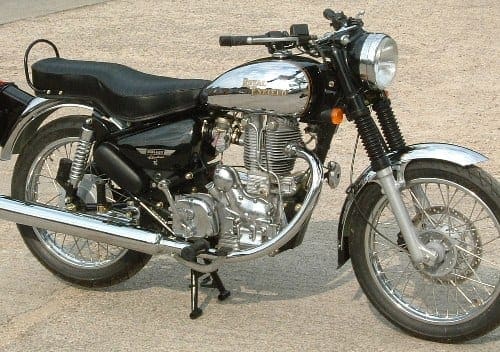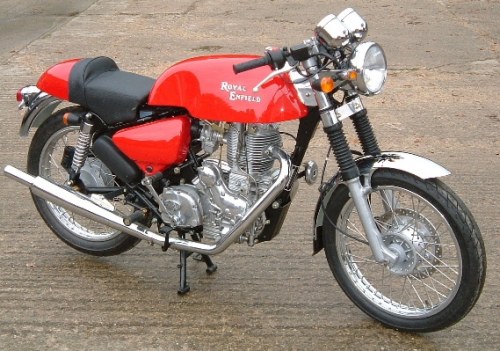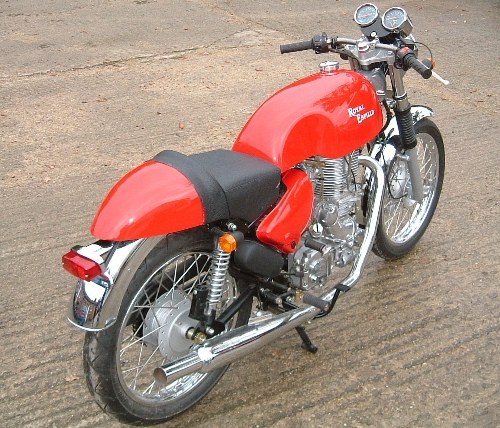
Alan Cole bid farewell to his old classic bikes, and road tested a pre-production special edition Enfield Electra in his search for a really practical classic. Did he like it enough to part with his cash?
Early in 2005 I decided to sell my 1942 Norton 16H, my 1954 BSA Gold Flash and my ‘everyday’ 1987 BMW R800 RT in order to invest in a brand new BMW R1200GS. The GS is a fantastic bike that is a real all-rounder, doing everything I want of it. The trouble is – it’s too good. There’s nothing that needs to be fiddled with and when it does go wrong the only resort is the local dealer, unless you have a BMW diagnostic machine in your garage!
So, a year later, I began to suffer spanner withdrawal syndrome and started to look for a classic bike again. I know, I can hear you saying, ‘will he never learn?!’
I was brought up with 1960’s bikes so Royal Enfield is very much in my vocabulary together with ‘café racer’. I’d never had a bike of this style and began to dream of buying a derelict featherbed Norton and any old Triumph 500 or 650 twin to construct my own. On the other hand, I had to live with the expense of restoring my Norton and BSA so I thought there had to be a better way.
Enter Royal Enfield.
Some of the background to the current RE concern has already been covered on this site – but for those of you who don’t know the history… Royal Enfield’s Bullet has been in continuous production since 1949. In 1955 the British HQ at Redditch established a satellite factory to help meet demand from the Indian Army. When the UK factory closed in 1970, the Indian plant continued to manufacture Bullet models.
24 years later Enfield India Ltd was acquired by the large engineering group, Eicher, who have since made a considerable investment in manufacturing equipment and techniques. This resulted in the launch of the Bullet Sixty-5 in 2004 with electric start and a 5-speed gearbox, which was designed by Dr Stuart McGuigan of Cranfield University, closely followed by the Bullet Electra 500 with a lean-burn all alloy engine, electronic ignition, roller main bearings, proper gear type oil pump and front disc brake. This was the bike which Rowena and Emm rode for nearly 3000 miles around Britain in 2005, and it covered that distance in just 11 days.
|
So, after 55 years, the Bullet has a new engine, designed and developed in conjunction with the Austrian power-train systems company, AVL. It retains the traditional appearance, simplicity, and sound of the British single but with greater inherent reliability and performance coupled with better fuel consumption and the ability to meet anticipated emissions legislation. The new model looks similar to the classic British bike of the mid-1950s but it is actually the result of international co-operation. Watsonian Squire has imported Royal Enfield motorcycles into the UK since 1999. As the oldest surviving sidecar manufacturer in the world they are extremely knowledgeable about classic bikes and are located barely 25 miles from the original Royal Enfield factory. Not surprisingly the UK is the biggest single export market for the Indian produced Enfields so Watsonian Squire have a significant degree of influence with the factory. Although Enfield India have come in for a lot of criticism over build quality what you se is what you get, although both technology and build quality have improved recently. There are a growing choice of models in the 500 Electra range; the standard 1950s look Classic, a trials styled machine, the café-racer styled Sportsman and now the XR model, which is a limited edition café racer produced in conjunction with Motorcycle News to commemorate both companies’ fiftieth anniversaries. After doing all my research I decided that the bike which would fulfil all my dreams was the Bullet 500 Electra XR. I thought that a test ride was essential so set off on the GS for Watsonian Squire’s HQ, near Moreton-in-Marsh, early on a very cold January morning. |
Enfield stuff on eBay.co.uk |
I almost fell in love at first sight of the gleaming pre-production 500 Electra XR. Watsonian Squire has discarded the traditional casquette headlamp casing in favour of a separate halogen headlight and twin clocks. With the styling and red colour scheme, evocative of the original Continental GT, the engine has been tuned to increase the standard 500 Bullet Electra power output by 30%, up from 23bhp to 30bhp. This has been achieved by adding a 32mm Dellorto carburettor, a modified air filter and a free-flow Gold Star type silencer.

Other modifications include frame revisions, new front forks and mudguards, a 280mm hydraulic front disc brake, gas filled rear dampers, Avon tyres, restyled panels, indicators and tank badges. Together with higher gearing these changes give the Electra-XR a huge advantage over the original India 500 Sportsman models.
Altogether the XR really looks the part – a typical 60’s café racer complete with swept back exhaust, straight and flat forward mounted sports bars, racing tank, solo racing seat, rear sets — and no passenger pegs! Would it ride as well as it looked? I was about to find out.
At around 410lbs dry weight my first impression was how tiny it looked compared to modern machines. Sitting on the bike on its centrestand, it felt positively minuscule compared to the GS. The fuel tap and choke are exactly where you’d expect to find them, under the left of the tank. I was advised to let the engine warm up before riding off as it is difficult to locate the choke to open it fully with gloves on. Although the bike has an electric start I elected not to use it and after turning the engine over using the kick-start and the decompressor one big kick from just beyond tdc on the compression stroke had it roaring into life. ‘Roaring’ may actually be a bit of an overstatement; it is certainly loud but with that acceptable deep noise of a big single.
My first mistake was to flip the prop stand down before getting the bike off the centre stand. Not only is this unnecessary, as with heavy modern machines, but it also cuts the engine out whether the bike is in gear or not. Oh well, fairly modern technology in an old coat.
On moving off I was, again, impressed how light the bike was. All the controls were easy to use, a light clutch, comfortable one-down, four-up left gear change and the only thing that I would need to adjust was the rear brake lever position to suit me better. Particularly impressive was the way the warning lights, which include a neutral gear position indicator, were hidden beneath the black panel that forms the speedo and tacho mounting. Really the only things that give this bike away as not being as old as it looks are the handlebar switchgear and the direction indicators.

As I accelerated away, heading towards the A44 and Chipping Norton, the exhaust note was real music to my ears, sounding wonderful if you gave it a bit of stick and possibly even better on the overrun. I was pleasantly surprised at how free revving the 500 single was, all the way up to an indicated 140kph on the pre-production speedo. Once the Avons had warmed up enthusiastic cornering did not produce any heart stopping moments at all. The brakes did catch me out at first, probably because I have become so used to the BMW’s linked system, but used appropriately they are perfectly adequate, if not outstanding, in performance. I am certain, however, that the XR’s big front disc is a huge improvement on the predecessor’s front drum brake!
Overall the bike was a delight to ride, taking me back many years in nostalgic terms. It’s quick enough to mix it on A, B and unclassified roads and would even cope well with motorway traffic although I doubt many would find it comfortable on that type of road. It is a great bike for fine weather back road scratching, which is OK because I doubt that many would contemplate riding this sort of machine often on major routes as the fun of it is best appreciated on minor routes.
So, who will this machine appeal to most? My guess is mainly to older experienced riders who remember the heyday of the British bike. The enormous appeal of it is that it has all of the character of a big British single without the misery of owning and running something that is 40 to 50-years old. The other big benefit is that the price of this new bike is certainly going to be less than the cost of restoring a British classic. Above all else you get greater reliability, so there will be no more messing about with unleaded petrol additives, weeks off the road when the magneto needs a rewind or another long wait for replacement parts.
Would I buy a Bullet Electra-XR?
As soon as I got home I went to my local Royal Enfield dealer – Richardson’s of Ripley in Surrey – and left a deposit. Better be quick though, there are only going to be 50 produced for delivery in March and mine was the 13th order. I can hardly wait ’til March!




